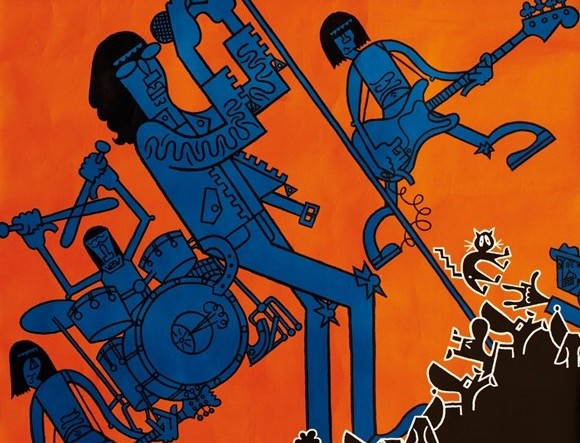
Courtesy of Monte Melnick.
“It’s the perfect place to grow up neurotic,” Tommy Ramone once told Interview magazine about Queens. A new exhibition dedicated to his influential punk group debuts at the Queens Museum of Art on April 10. “Hey! Ho! Let’s Go: Ramones and the Birth of Punk,” is already generating serious buzz, and is likely to be a record setter attendance-wise.
Danny Fields, The Ramones in the alley behind CBGB (1977).
Image: Courtesy of the Queens Museum of Art.
It is fitting that the museum, which is in Flushing, is not too far from the Forest Hills neighborhood where the legendary band members met and got their start, before eventually becoming a fixture of the Lower East Side’s energetically gritty 1970s music scene.
Shepard Fairey, Tommy Ramone (2015).
Image: Courtesy of the artist.
The Queens show coincides with the 40th anniversary of the band’s eponymous first album, and it celebrates their colorful history, and enduring influence. But Marc H. Miller, the artist and historian who guest curated the show insists that the “exhibit is as much an art show as it is a memorabilia show,” he said in a phone interview with artnet News.
Danny Fields, Ramones with Chrissie Hynde and Captain Sensible (1976)
Image: Courtesy of Danny Fields.
Of the now shuttered Lower East Side venue they frequently performed at, Miller says, “CBGB was more than just bands. It was was just swarming with artists—visual artists, photographers, writers, film-makers, fashion people—so the band was very fortunate in the kind of visual record that was created around them. The exhibition draws on that rich record.”
Richard Allen, Australian tour, October/November (1989)
Courtesy of Monte Melnick.
In 1978, Miller, who studied art history at NYU’s Institute of Fine Arts and was later chief curator at the Queens Museum, curated the first-ever show of “Punk Art” at Washington Project for the Arts. Having lived on the Bowery in the 1970s, he was immersed in the music scene, in all its permutations.
He notes how in some ways the formation of the band itself was an artistic concept, with the Ramones taking a cue from Andy Warhol to use branding as an art form. “Tommy was the one that put them together. He had this concept of getting four hoods out there, wearing leather jackets and ripped jeans. The rule was, ‘never smile,'” says Miller.
Tommy further recruited Danny Fields, who was part of Warhol’s entourage and managed numerous major bands, including the Velvet Underground, as a manager for the Ramones.
Keith Green, Dee Dee Ramone on Chelsea Hotel balcony (1992).
Photograph. Courtesy of Keith Green.
“Danny had his own talents. He was a very good photographer and as manager of the group, he said, ‘I had nothing to do all day but take pictures of them,’ so there is a very good collection of images,” said Miller.
Bill Santelli, director of the Grammy Museum, curated the show with Miller. When the Queens Museum show wraps up in late July, they expect the exhibition to travel, but dates and locations are still to be determined.
John Holstrom, Cover for Punk #3 (1976).
Image: Courtesy of the Rock & Roll Hall of Fame.
Along with memorabilia such as Punk magazine covers, tour posters, leather jackets, and high-top black sneakers, there is a large collection of photographs of the band performing and posing for publicity shots with their signature scowls.
Punk magazine artist John Holstrom is also creating a new poster that will be given away to visitors at the museum. It’s a cartoon map of the Ramones in Queens and in New York, with clubs they played, places they lived, and sites of some of their songs and hangouts. “He did quite a job. It took forever,” Miller notes.
Shepard Fairey, Joey Ramone (2015).
Courtesy of the artist.
Another sign of the band’s enduring influence? The number of contemporary artists who wanted to be involved with the show, including artists Yoshitomo Nara and Shepard Fairey.
Nara’s newly-created work is a giant five-by-seven foot painting depicting his signature character, Ramona. It shows her at the microphone and she’s screaming: “Hey! Ho! Let’s Go!,” the famous opening lines to “Blitzkrieg Bop”.
Stphen Kroninger, Joey Ramone (2001). Image: Courtesy of George Seminara
Four new paintings by Shepard Fairey, one of each of the Ramones, are placed at the end of the show. “They are variations on ones he painted before. But he never painted Tommy, so he added one,” Miller says.
“The philosophy is if you just let the band be themselves and present them as they presented themselves and the people around them,” Miller says, “then the magic is on.”